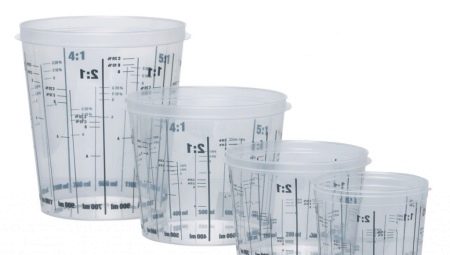To facilitate the cooking process, namely: measuring the amount of ingredients used, you can use various kitchen tools. However, in the process of operation, measuring cups stand out as the most convenient and inexpensive containers, presented in a wide variety of options.
What it is?
Measuring cup is in demand due to its versatility and practicality, because it allows you to make the process of determining the amount of ingredients used more accurate and quick. Today, such a device can be found not only in culinary workshops or restaurants - many housewives actively exploit the capacity in everyday life in ordinary home kitchens and not only.
A glass is a container in several volume options, which looks similar to a regular glass or a mug, as some modern models are additionally equipped with a handle for greater comfort in use.
In addition, measuring devices usually have a small spout-gutter, which, after counting, will help to neatly pour or transfer the measured substances from a glass into another dish.
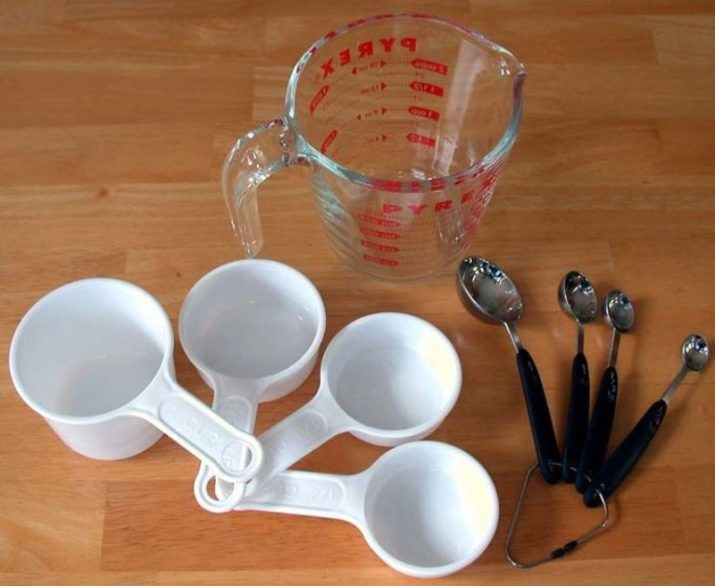
It distinguishes a glass from ordinary dishes by the presence of a special scale drawn on the walls, thanks to which it will be possible to accurately determine the amount (mass, volume) of bulk solids, viscous substances or liquids inside. Most often, containers are made in a cylindrical shape, however, options in different versions are also on sale.
As a raw material for the manufacture of containers is usually used glass, polymer, plastic, silicone. Today merchants meet in different volumes, on sale you can find small containers designed for 250-500 ml or a more capacious container, the displacement of which can exceed 2000 ml.
Among the fundamental differences in measuring glasses, it is worth noting the design of the scale, where the ingredients can be measured not only in milliliters, but also in grams. And there are also dual gauges, where the manufacturer for convenience indicates two options for measuring products.
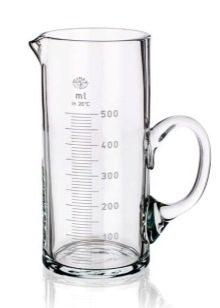

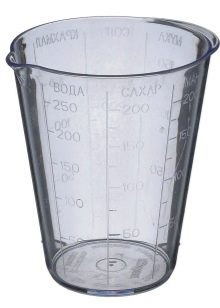
Varieties
Distinguish similar containers according to several fundamental criteria. This applies to different characteristics.
Material
The quality of the utensils used largely depends on the raw materials used for manufacturing. Most often, the manufacturer offers the following options for measuring devices:
- plastic;
- glass;
- metal;
- ceramic;
- silicone.
Plastic glasses are in greatest demand, since the material itself stands out for its affordability, durability and long service life. Taking into account the specifics of packaging production, measuring devices can be opaque or transparent. In addition, containers can be made from hard or soft raw materials, so each cook will be able to choose a container that is ideally suited to his needs, while the products will have an affordable cost.
From the advantages of the polymer it is worth highlighting its resistance to mechanical damage.However, some new products are capable of retaining the specific smell of plastic for a long time.
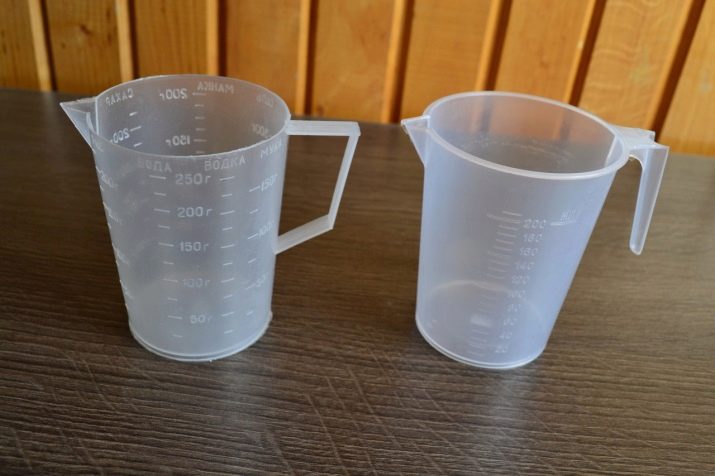
Glass glasses have a more respectable and attractive appearance. Such containers may be among the categories of goods with a higher value. However, raw materials are characterized by their hygiene, which is important not only for home kitchens, but also for public institutions - restaurants, cafes. Among the shortcomings, it is worth highlighting the fragility of glass, but manufacturers quite often produce measuring devices from heat-resistant raw materials, which allows pouring even hot liquid for measuring volume into it without fear.
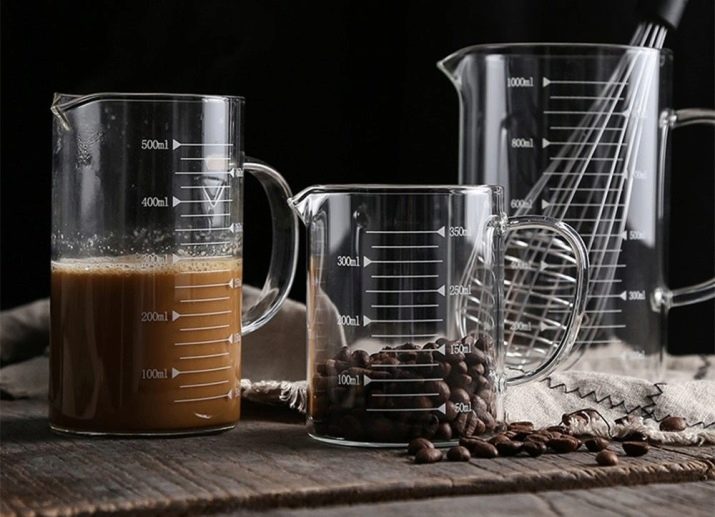
As for metal containers, most of them are made of stainless steel. These glasses fit perfectly into the interior of even the most modern kitchens and work areas. The products are very easy to clean. But even if you use the stainless steel glass as carefully as possible, scratches form on its surface during operation, which adversely affect the appearance.
If the manufacturer used a thin sheet of metal in the production, but when dropped, the meter body can be deformed.

Also on sale ceramic containers. They are notable for their diverse appearance, color, and may have an unusual shape; some companies offer containers of non-standard volume.
Raw materials can be used in direct contact with food, since ceramics belongs to environmentally friendly materials. However, glasses made of such a material are not distinguished by their durability; during operation, they often form chips or cracks on the surface. In addition, during use it can be difficult to understand the divisions due to the opacity of the case.

Silicone mernicks can attract the attention of consumers at an affordable cost and appearance, however, during use, such containers are very easily deformed under the mass of substances inside, because they do not have rigid walls. However, the flexibility of the glasses facilitates their operation, in addition, the silicone will not be damaged from falling.

Volume
Taking into account the volume, measuring glasses are different, so the choice must be based on the personal preferences of the hostess or cook. Today, the most popular containers are measuring tanks with a volume of 50 ml to 1000 ml. They are found on store shelves most often.Less often, manufacturers offer products whose volumes will exceed 1 liter, but for large culinary enterprises it will be possible to purchase containers designed for 5 or more liters.
All products are manufactured, taking into account GOST. The choice of the scale option for measuring in grams or milliliters is based on the personal needs and preferences of the consumer.
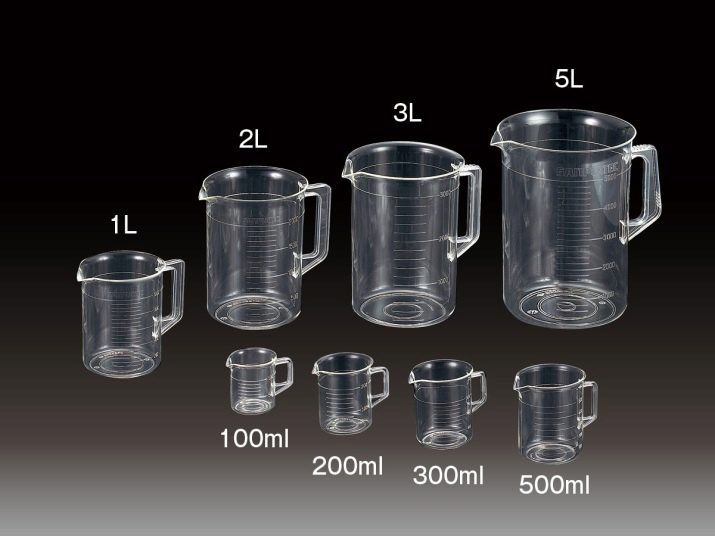
Manufacturers Overview
Today, many domestic and foreign manufacturers are engaged in the manufacture and sale of measuring glasses. Among the popular brands and products it is worth highlighting.
Bormioli Rocco Frigoverre
The manufacturer offers 1 liter glasses. Products are made of safe high-quality glass; for the convenience of storage and operation, the container is sold together with a plastic lid. The diameter of the container is 11 centimeters with a height of 15.5 centimeters.
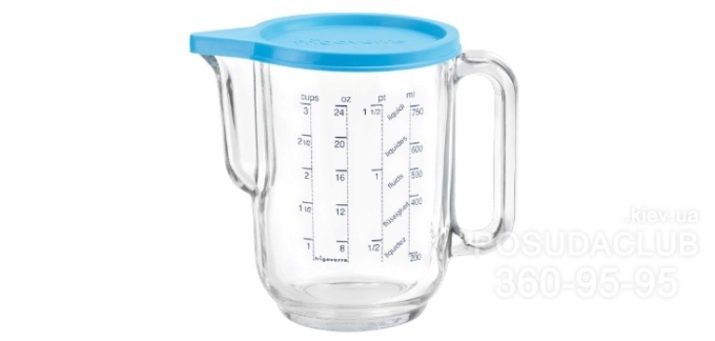
Leifheit comfortline
A 0.5 liter safe polymer tank can be used to measure liquid and bulk ingredients. The container body is transparent, which greatly facilitates operation. Tara is easy to clean additionally equipped with a rubberized layer at the bottom, which prevents the tank from sliding on the surface.
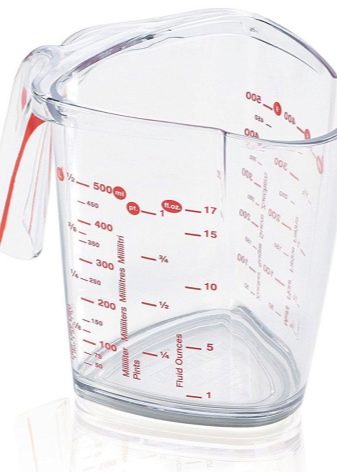
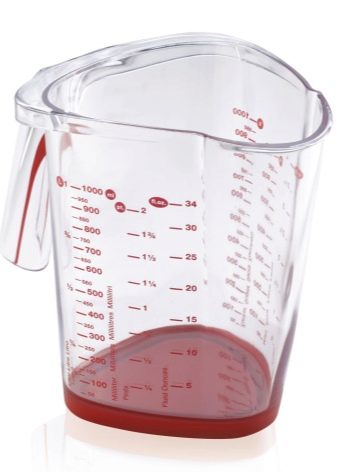
Simax 0.5 L
Convenient packaging made of thermal glass, resistant to temperature extremes in the range from -40 ° C to + 300 ° C. Thanks to this feature it can not only measure products, but also cook or freeze the ingredients.
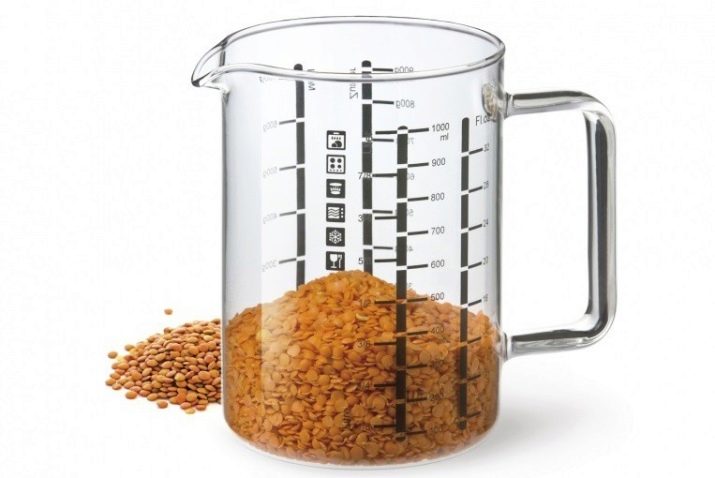
"Horizon" 250 ml
Small-capacity plastic container recommended for domestic use. Suitable for measuring liquid and granular media.
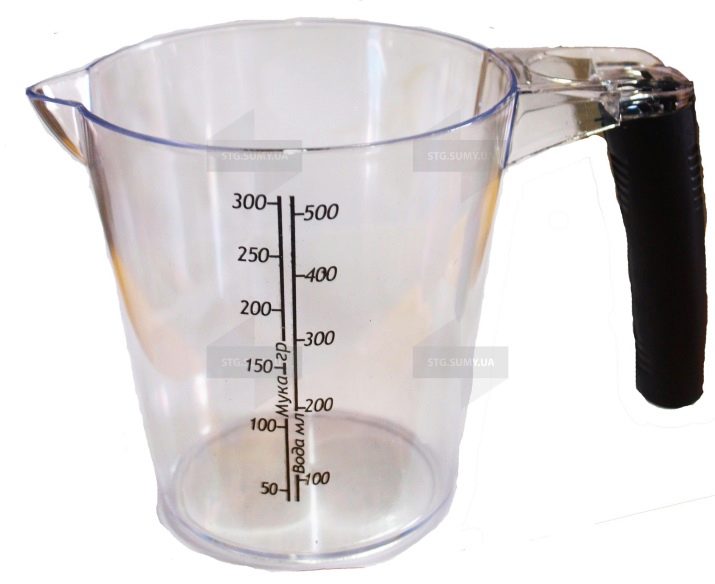
How to choose?
To choose the right container for measurement, some nuances should be taken into account.
- It is important that the products offered are made from environmentally friendly raw materials that will not react with the products.
The use of other containers should be discarded in order to avoid changes in the chemical and taste qualities of the measured ingredients.
- It is also worth deciding on suitable volumes. For large food enterprises, measuring devices of more than one liter will be needed, as for ordinary home use, a glass of 0.5-1 liter will be enough.
- Design, color of the tank is selected from personal taste preferences. You can base your choice on the compliance of the measurer to other dishes.
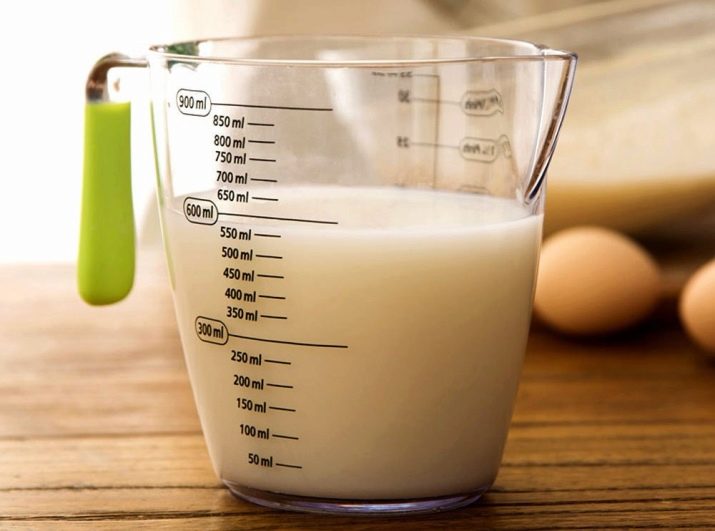
Terms of use
Measuring cup will help to comply with all prescription recommendations. However, even with such a simple kitchen device, it’s worth working with certain rules.
- The first recommendation is to use only a dry measuring tank. Moreover, this applies to the internal and external walls of the meter. In this way, slippage of the wet tank can be avoided; moreover, bulk materials will not stick to surfaces, complicating the calculations.
- All viscous and bulk products are best loaded into a container with a spoon. This will help maintain their consistency - so the ingredients will evenly fill the container.
- Loose - cereals, flour - it is recommended to shake a little in a glass to avoid the formation of an air gap.
- If it will be easy to pour water into the glass, then the remaining liquids should be poured strictly along the wall of the measuring device, tilting it a bit to avoid foam formation, or not waiting until the sediment settles on the bottom of the glass.
- If the products will be further subjected to additional sifting or sorting, their quantity will change, therefore it is recommended to use a measuring cup after the described procedures.
- All measurements, even with a minimum volume of 30, 50 or 100 ml, must be carried out exclusively on a flat surface. It is forbidden to work with a canopy because the calculations will be erroneous.
- If you want to measure an ingredient such as butter, it should be cut into small pieces. This is to prevent the formation of air pockets.
- Since during the preparation of dishes it may be necessary to measure several products, including bulk and liquid ones, the first thing to do is to pour dry ingredients into a glass in order to avoid their uneven distribution over wet walls.
- It is easier to recruit and adjust a larger volume, usually the extra slide is simply removed with a knife in the case of bulk products.
- In any case, whether it is a measurement with a special measuring device with a scale or an ordinary faceted glass, for the accuracy of determining the volumes, normal humidity in the room is needed. The higher it is, the greater will be the volume of working ingredients.
- Small portions will be easier to measure in the smallest measuring devices.
Adhering to the rules described above, it will be possible to achieve the most accurate result with the determination of the volumes of almost any product.
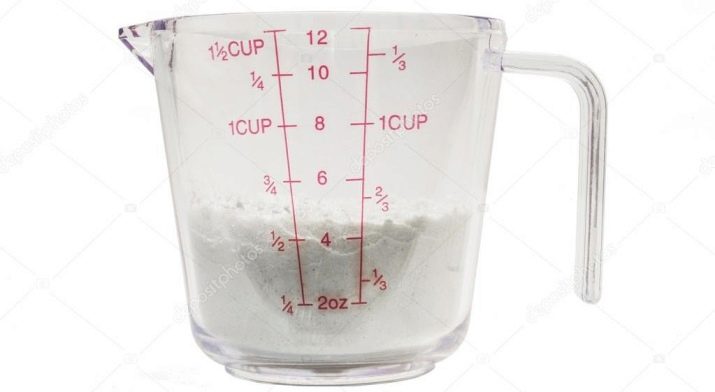
Care Features
Most of the measuring cups are made taking into account their use as kitchen utensils, therefore, the manufacturer suggests that the washing, care and further storage of such containers will be carried out with the remaining containers in operation.
The type of washing and the use of household chemicals will directly depend on the type of raw material from which the glass is made. As a rule, almost all materials endure manual processing in hot water using liquid chemistry without abrasive particles.
An exception may be ceramics and glass, which are not recommended to be washed with sponges with a hard side, as well as to clean from dirt in dishwashers.
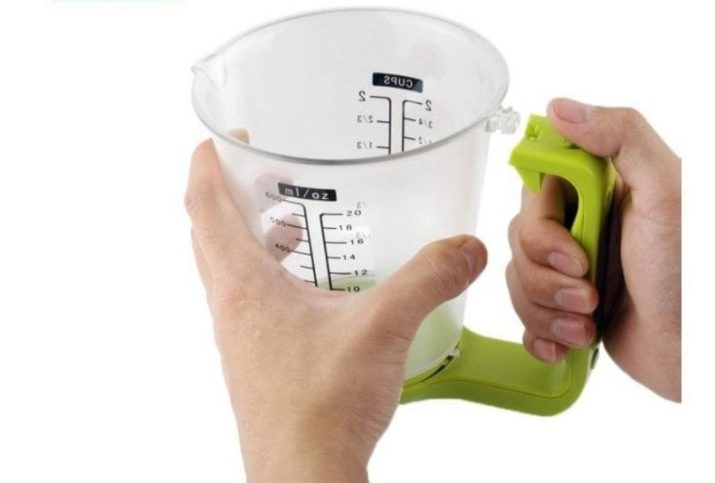
See the following video for more information on measuring cups.
